Buddhism › Bulguksa Temple › Mummification in Ancient Egypt » Origins and History
Articles and Definitions › Contents
- Buddhism › Origins
- Bulguksa Temple › Origins
- Mummification in Ancient Egypt › Origins
Ancient civilizations › Historical places, and their characters
Buddhism › Origins
Definition and Origins
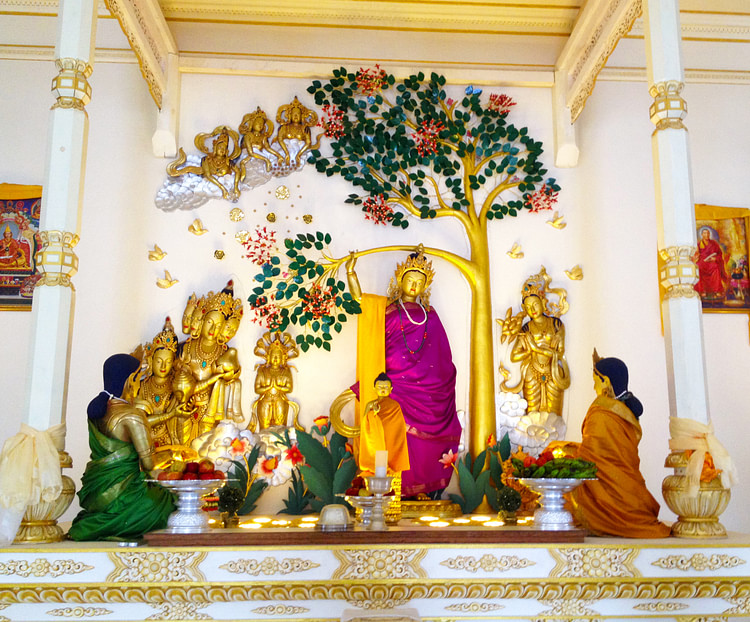
Buddhism is one of the most important Asian spiritual traditions. During its roughly 2.5 millennia of history, Buddhism has shown a flexible approach, adapting itself to different conditions and local ideas while maintaining its core teachings. As a result of its wide geographical expansion, coupled with its tolerant spirit, Buddhism today encompasses a number of different traditions, beliefs, and practices.
During the last decades, Buddhism has also gained a significant presence outside Asia. With the number of adherents estimated to be almost 400 million people, Buddhism in our day has expanded worldwide, and it is no longer culturally specific.For many centuries, this tradition has been a powerful force in Asia, which has touched nearly every aspect of the eastern world: arts, morals, lore, mythology, social institutions, etc. Today, Buddhism influences these same areas outside of Asia, as well.
ORIGIN & EARLY DEVELOPMENT
The origin of Buddhism points to one man, Siddhartha Gautama, the historical Buddha, who was born in Lumbini (in present-day Nepal) during the 5th century BCE. Rather than the founder of a new religion, Siddhartha Gautama was the founder and leader of a sect of wanderer ascetics ( Sramanas ), one of many sects that existed at that time all over India.This sect came to be known as Sangha to distinguish it from other similar communities.
The Sramanas movement, which originated in the culture of world renunciation that emerged in India from about the 7th century BCE, was the common origin of many religious and philosophical traditions in India, including the Charvaka school, Buddhism, and its sister religion, Jainism. The Sramanas were renunciants who rejected the Vedic teachings, which was the traditional religious order in India, and renounced conventional society.
Siddhartha Gautama lived during a time of profound social changes in India. The authority of the Vedic religion was being challenged by a number of new religious and philosophical views. This religion had been developed by a nomadic society roughly a millennium before Siddhartha's time, and it gradually gained hegemony over most of north India, especially in the Gangetic plain. But things were different in the 5th BCE, as society was no longer nomadic: agrarian settlements had replaced the old nomad caravans and evolved into villages, then into towns and finally into cities. Under the new urban context, a considerable sector of Indian society was no longer satisfied with the old Vedic faith. Siddhartha Gautama was one of the many critics of the religious establishment.
IN SOME RELIGIONS, SIN IS THE ORIGIN OF HUMAN SUFFERING. IN BUDDHISM THERE IS NO SIN; THE ROOT CAUSE OF HUMAN SUFFERING IS AVIDYĀ “IGNORANCE”.
After Siddhartha Gautama passed away, the community he founded slowly evolved into a religion-like movement and the teachings of Siddhartha became the basis of Buddhism. The historical evidence suggests that Buddhism had a humble beginning. Apparently, it was a relatively minor tradition in India, and some scholars have proposed that the impact of the Buddha in his own day was relatively limited due to the scarcity of written documents, inscriptions, and archaeological evidence from that time.
By the 3rd century BCE, the picture we have of Buddhism is very different. The Mauryan Indian emperor Ashoka the Great (304–232 BCE), who ruled from 268 to 232 BCE, turned Buddhism into the state religion of India. He provided a favourable social and political climate for the acceptance of Buddhist ideas, encouraged Buddhist missionary activity, and even generated among Buddhist monks certain expectations of patronage and influence on the machinery of political decision making. Archaeological evidence for Buddhism between the death of the Buddha and the time of Ashoka is scarce; after the time of Ashoka it is abundant.
SCHISM: FRACTURE OF BUDDHISM & ORIGIN OF THE DIFFERENT BUDDHIST SCHOOLS
There are many stories about disagreements among the Buddha's disciples during his lifetime and also accounts about disputes among his followers during the First Buddhist Council held soon after the Buddha's death, suggesting that dissent was present in the Buddhist community from an early stage. After the death of the Buddha, those who followed his teachings had formed settled communities in different locations. Language differences, doctrinal disagreements, the influence of non-Buddhist schools, loyalties to specific teachers, and the absence of a recognized overall authority or unifying organizational structure are just some examples of factors that contributed to sectarian fragmentation.
About a century after the death of Buddha, during the Second Buddhist Council, we find the first major schism ever recorded in Buddhism: The Mahasanghika school. Many different schools of Buddhism had developed at that time. Buddhist tradition speaks about 18 schools of early Buddhism, although we know that there were more than that, probably around 25. A Buddhist school named Sthaviravada (in Sanskrit “school of the elders”) was the most powerful of the early schools of Buddhism. Traditionally, it is held that the Mahasanghika school came into existence as a result of a dispute over monastic practice. They also seem to have emphasized the supramundane nature of the Buddha, so they were accused of preaching that the Buddha had the attributes of a god. As a result of the conflict over monastic discipline, coupled with their controversial views on the nature of the Buddha, the Mahasanghikas were expelled, thus forming two separate Buddhist lines: the Sthaviravada and the Mahasanghika.
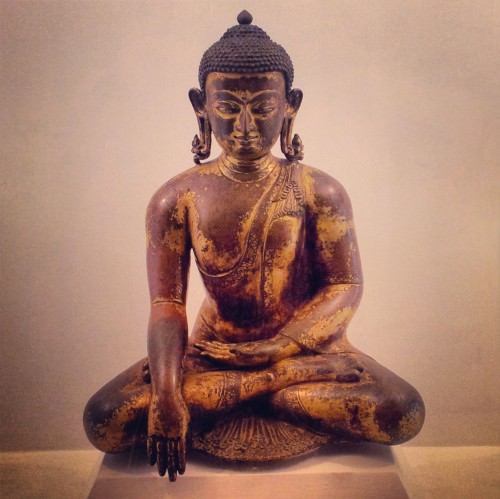
Siddhartha Gautama, the Historical Buddha
During the course of several centuries, both the Sthaviravada and the Mahasanghika schools underwent many transformations, originating different schools. The Theravada school, which still lives in our day, emerged from the Sthaviravada line, and is the dominant form of Buddhism in Myanmar, Cambodia, Laos, Sri Lanka, and Thailand. The Mahasanghika school eventually disappeared as an ordination tradition.
During the 1st century CE, while the oldest Buddhist groups were growing in south and south-east Asia, a new Buddhist school named Mahayana (“Great Vehicle”) originated in northern India. This school had a more adaptable approach and was open to doctrinal innovations. Mahayama Buddhism is today the dominant form of Buddhism in Nepal, Tibet, China, Japan, Mongolia, Korea, and Vietnam.
BUDDHIST EXPANSION ACROSS SOUTHERN ASIA
During the time of Ashoka's reign, trade routes were opened through southern India. Some of the merchants using these roads were Buddhists who took their religion with them. Buddhist monks also used these roads for missionary activity. Buddhism entered Sri Lanka during this time. A Buddhist chronicle known as the Mahavamsa claims that the ruler of Sri Lanka, Devanampiya Tissa, was converted to Buddhism by Mahinda, Ashoka's son, who was a Buddhist missionary, and Buddhism became associated with Sri Lanka's kingship: The tight relationship between the Buddhist community and Lankan's rulers was sustained for more than two millennia until the dethroning of the last Lankan king by the British in 1815 CE.
After reaching Sri Lanka, Buddhism crossed the sea into Myanmar (Burma): Despite the fact that some Burmese accounts say that the Buddha himself converted the inhabitants of Lower and Upper Myanmar, historical evidence suggests otherwise.Buddhism co-existed in Myanmar with other traditions such as Brahmanism and various locals animists cults. The records of a Chinese Buddhist pilgrim named Xuanzang (Hsüan-tsang, 602-664 CE) state that in the ancient city of Pyu (the capital of the Kingdom of Sri Ksetra, present day Myanmar), a number of early Buddhist schools were active. After Myanmar, Buddhism travelled into Cambodia, Thailand, Vietnam, and Laos, around 200 CE. The presence of Buddhism in Indonesia and the Malay peninsula is supported by archaeological records from about the 5th century CE.

The Spread of Buddhism
While Buddhism was flourishing all over the rest of Asia, its importance in India gradually diminished. Two important factors contributed to this process: a number of Muslim invasions, and the advancement of Hinduism, which incorporated the Buddha as part of the pantheon of endless gods; he came to be regarded as one of the many manifestations of the god Vishnu. In the end, the Buddha was swallowed up by the realm of Hindu gods, his importance diminished, and in the very land where it was born, Buddhism dwindled to be practiced by very few.
BUDDHIST EXPANSION ACROSS CENTRAL & EAST ASIA
Buddhism entered China during the Han dynasty (206 BCE-220 CE): The first Buddhist missionaries accompanied merchant caravans that travelled using the Silk Road, probably during the 1st century BCE. The majority of these missionaries belonged to the Mahayana school.
The initial stage of Buddhism is China was not very promising. Chinese culture had a long-established intellectual and religious tradition and a strong sense of cultural superiority that did not help the reception of Buddhist ideas. Many of the Buddhist ways were considered alien by the Chinese and even contrary to the Confucian ideals that dominated the ruling aristocracy. The monastic order received a serious set of critiques: It was considered unproductive and therefore was seen as placing an unnecessary economic burden on the population, and the independence from secular authority emphasized by the monks was seen as an attempt to undermine the traditional authority of the emperor.
Despite its difficult beginning, Buddhism managed to build a solid presence in China towards the fall of the Han dynasty on 220 CE, and its growth accelerated during the time of disunion and political chaos that dominated China during the Six Dynasties period (220-589 CE). The collapse of the imperial order made many Chinese skeptical about the Confucian ideologies and more open to foreign ideas. Also, the universal spirit of Buddhist teachings made it attractive to many non-Chinese ruler in the north who were looking to legitimate political power. Eventually, Buddhism in China grew strong, deeply influencing virtually every aspect of its culture.
From China, Buddhism entered Korea in 372 CE, during the reign of King Sosurim, the ruler of the Kingdom of Koguryo, or so it is stated in official records. There is archaeological evidence that suggests that Buddhism was known in Korea from an earlier time.
The official introduction of Buddhism in Tibet (according to Tibetan records) took place during the reign of the first Tibetan emperor Srong btsan sgam po (Songtsen gampo, 617-649/650 CE), although we know that the proto-Tibetan people had been in touch with Buddhism from an earlier time, through Buddhist merchants and missionaries. Buddhism grew powerful in Tibet, absorbing the local pre-Buddhist Tibetan religions. Caught between China and India, Tibet received monks from both sides and tension between Chinese and Indian Buddhist practice and ideology turned out to be inevitable. From 792 to 794 CE a number of debates were held in the Bsam yas monastery between Chinese and Indian Buddhists. The debate was decided in favour of the Indians: Buddhists translations from Chinese sources were abandoned and the Indian Buddhist influence became predominant.
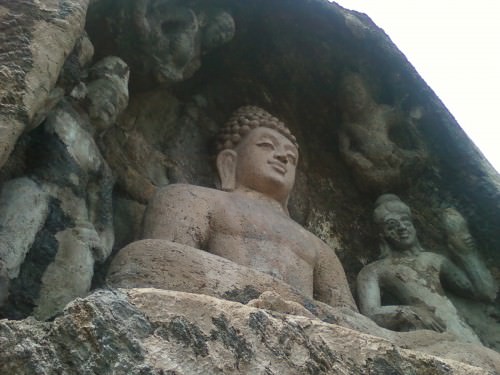
A rock cut image of the Buddha
KEY BUDDHIST CONCEPTS
The Buddha was not concerned with satisfying human curiosity related to metaphysical speculations. Topics like the existence of god, the afterlife, or creation stories were ignored by him. During the centuries, Buddhism has evolved into different branches, and many of them have incorporated a number of diverse metaphysical systems, deities, astrology and other elements that the Buddha did not consider. In spite of this diversity, Buddhism has a relative unity and stability in its moral code.
The most important teaching of the Buddha is known as “The Four Noble Truths ”, which is shared with varying adjustments by all Buddhist schools. In general, the Four Noble Truths are explained as follows:
- The First Noble Truth is generally translated as “all life is suffering”, which can be easily understood when it comes to painful situations like death, illness, abuse, poverty, and so forth. But suffering also may arise from good things because nothing is permanent, everything is changing, and whatever gives us happiness will sooner or later come to an end. It seems that all pleasures are temporary and the more we enjoy them, the more we will miss them when they end.“Nothing lasts forever”, is one of the insights of the Buddha.
- The cause of suffering is desire. Suffering comes from desire, also referred as “thirst” or greed. Our desires will always exceed our resources and leave us unhappy and unsatisfied. All suffering originates in desire, but not all desire generates suffering. Only selfish desire generates suffering: desire directed to the advantage of the part rather than to the good of the whole.
- By stopping desire, suffering also stops. The idea is not to get too attached to material goods, places, ideas, or even people. Non-attachment to anything is the main idea behind the third noble truth. It means that since all changes if our attachment is too strong, we will inevitably suffer at some point. After all, we will all get old, decay, and die; this is a natural cycle, and there is nothing wrong with it. The problem comes when, by attaching too much, we do not accept the changes.
- By following “The Eightfold Path”, desire stops. The Eightfold Path is composed of: right views, right intentions, right speech, right action, right livelihood, right effort, right mindfulness and right concentration.
In some religions, sin is the origin of human suffering. In Buddhism there is no sin; the root cause of human suffering is avidyā“ignorance”. In the entrance area of some Buddhist monasteries, sometimes the images of four scary-looking deities are displayed, the four protectors whose purpose is to scare away the ignorance of those who enter.

Gandhara Relief of Buddha Eating with Monks
Buddhism does not require faith or belief. If faith can be understood as believing something which is unsupported by evidence, and ignorance is overcome by understanding, then faith is not enough to overcome ignorance and therefore suffering. And belief, as understood by other religions, is not necessary in Buddhism:
“The question of belief arises when there is no seeing - seeing in every sense of the word. The moment you see, the question of belief disappears. If I tell you that I have a gem hidden in the folded palm of my hand, the question of belief arises because you do not see it yourself. But if I unclench my fist and show you the gem, then you see it for yourself, and the question of belief does not arise. So the phrase in ancient Buddhist texts reads 'Realizing, as one sees a gem in the palm'”(Rahula W., p.9)
In its most basic form, Buddhism does not include the concept of a god. The existence of god is neither confirmed, nor denied;it is a non-theistic system. The Buddha is seen as an extraordinary man, not a deity. Some Buddhist schools have incorporated supernatural entities into their traditions, but even in these cases, the role of human choice and responsibility remains supreme, far above the deeds of the supernatural.
In some Chinese and Japanese Buddhist monasteries, they go even further by performing a curious exercise: The monks are requested to think that the Buddha did not even existed. There is a good reason for this: the core of Buddhism is not the Buddha, but his teachings or dharma. It is said that those who wish to understand Buddhism and are interested in the Buddha are as mistaken as a person who wishes to study mathematics by studying the life of Pythagoras or Newton. By imagining the Buddha never existed, they avoid focusing on the idol so that they can embrace the ideal.
Bulguksa Temple › Origins
Definition and Origins
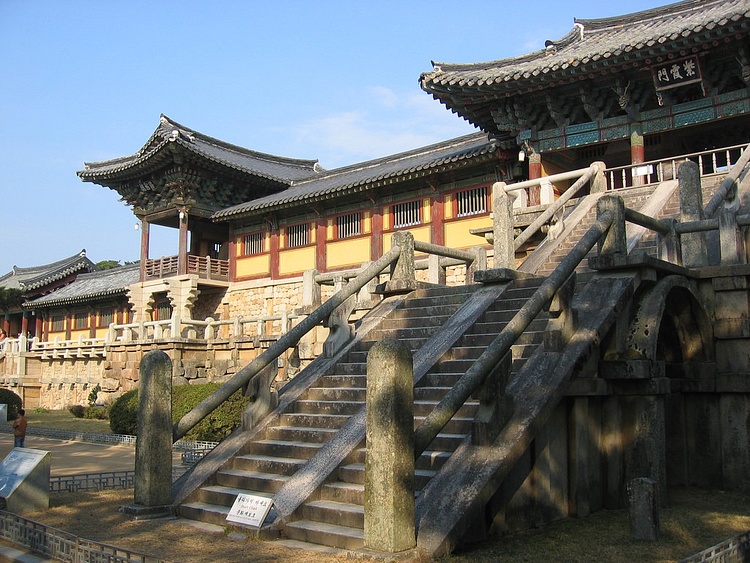
The Bulguksa Temple (aka Pulguk-sa Temple or 'Temple of the Buddha Land') was built in the 8th century CE on the wooded slopes of Mt. Tohamsan at the ancient Silla capital of Kumsong (modern Gyeongju, South Korea ). The Buddhisttemple, after suffering a destructive fire, now stands restored but is only a fraction of its original size. The temple and nearby Seokguram Grotto with its huge seated Buddha statue is recognised by UNESCO as a World Heritage Site.
The temple was built on an earlier foundation set when the territory was controlled by the Baekje (Paekje) kingdom (18 BCE - 660 CE). The chief architect of Bulguksa is traditionally credited as Kim Dae-seong (700-774 CE), the Chief Minister or chungsi of the Unified Silla kingdom which ruled Korea from 668 to 935 CE. The period saw a great deal of Buddhist architecture spring up across Korea, but Bulguksa is widely regarded as one of the finest complexes dedicated to the official state religion of Korea.
THE LAND OF BUDDHA
The complex, as its name suggests, was designed to represent the land of Buddha, that is paradise. For this reason, there are three principal zones: Birojeon (Vairocana Buddha Hall), Daeungjeon (Hall of Great Enlightenment and main temple), and Geungnakjeon (Hall of Supreme Bliss). The halls, constructed in wood and stone with tiled roofs, are each built on a raised stone terrace.

Daeungjeon Hall, Bulguksa
This architectural representation of paradise, which rises symmetrically from a lotus lake, is symbolically entered via two stone bridges and a large staircase, reminding the visitor that they are leaving the earthly realm behind them and stepping into the sacred realm of Buddha. The entrance gate, known as the Mauve Mist Gate ( Chaha- mun ) is approached by the 'cloud bridge' staircase. The visitor must climb a lower flight of steps known as the Bridge of White Clouds ( Paekun - gyo ) and then an upper flight with the name Bridge of Azure Clouds ( Chongun - gyo ). Besides the three large halls, the complex included floating pavilions and living quarters for monks as it also functioned as a monastery. The combined floor space of all of these structures was said to cover 2,000 kan (one kan being the space within four columns).The temple complex was so large and built with such precise mathematical and geometrical considerations that it took almost 40 years to complete, beginning with the traditional start date of 751 CE and finishing in 790 CE.
DABOTAP & SEOKGATAP PAGODAS
Although the original wooden buildings of Bulguksa have long since disappeared the temple does have two surviving stone pagodas – the Dabotap (Tabo-tap or 'Pagoda of Many Treasures') and Seokgatap (Sokka-tao or 'Pagoda that Casts No Shadow') – which both traditionally date 751 CE. Stone pagodas are Korea's unique contribution to Buddhist architecture, and they usually stood as a pair in a courtyard in front of the main temple hall, as was the case with these two at Bulguksa which stand before the Daeungjeon Hall.
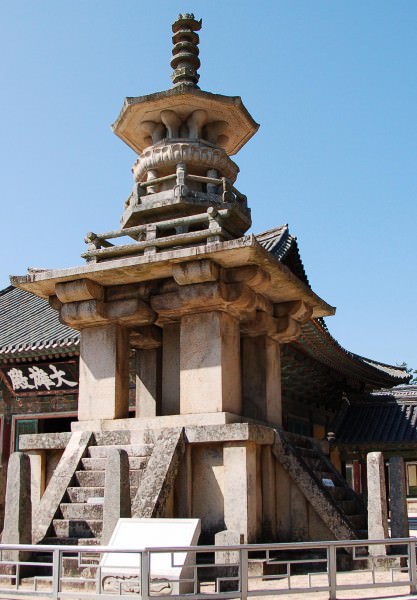
Dabotap Pagoda, Gyeongju
The Dabotap pagoda, which represents the Dabo Buddha, is the more complex of the two and stands at the east side. It has a square base with a columned pavilion accessed by a short flight of stairs on each of the four sides. The pavilion may once have housed an image of Buddha and at the top of the western stairs is a stone lion, a design which may originally have been repeated on the other three staircases. Above are multiple octagonal levels with columns in the form of bamboo stalks and then circular, flower-shaped layers at the top. The Seokgatap, on the west side and representing Sakyamuni Buddha, is a simpler affair and has a large square base and then three prominent square levels topped by a thin spire. Excavation around the Seokgatap pagoda in 1966 CE brought to light a sarira (reliquary casket) containing the world's oldest woodblock-printed document, a copy of the Dharani sutra.
LATER HISTORY & RESTORATION
Many of the temple complex's wooden buildings were, unfortunately, destroyed during the Japanese invasions known as the Imjin Wars (1592-8 CE). Restorations were made over the centuries, often based on ancient descriptions, but the complex is much smaller than the original. The two pagodas and two of the bridges all feature on the official list of National Treasures of Korea.
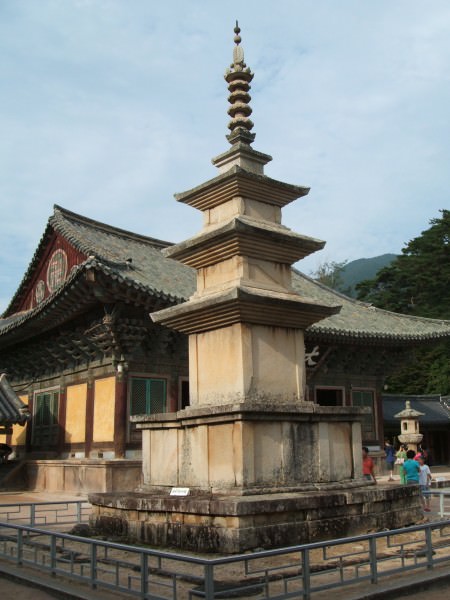
Seokgatap Pagoda, Gyeongju
SEOKGURAM GROTTO
Nearby Bulguksa, set into the upper south-eastern slopes of the Tohamsan mountain, is the Seokguram Grotto (Sokkuram).This Buddhist cave temple was constructed as an artificial grotto between 751 and 774 CE, again by Kim Dae-seong. The circular inner chamber has a domed roof and a white granite statue of the Sakyamuni Buddha which is 3.45 metres high. The walls of the grotto are decorated with 41 figure sculptures set in niches. Seokguram features at position no. 24 on the official state list of National Treasures of Korea.
This article was made possible with generous support from the British Korean Society.
Mummification in Ancient Egypt › Origins
Ancient Civilizations
The practice of mummifying the dead began in ancient Egypt c. 3500 BCE. The English word mummy comes from the Latin mumia which is derived from the Persian mum meaning 'wax' and refers to an embalmed corpse which was wax-like. The idea of mummifying the dead may have been suggested by how well corpses were preserved in the arid sands of the country.
Early graves of the Badarian Period (c. 5000 BCE) contained food offerings and some grave goods, suggesting a belief in an afterlife, but the corpses were not mummified. These graves were shallow rectangles or ovals into which a corpse was placed on its left side, often in a fetal position. They were considered the final resting place for the deceased and were often, as in Mesopotamia, located in or close by a family's home.

Male Egyptian Mummy with Amulets
Graves evolved throughout the following eras until, by the time of the Early Dynastic Period in Egypt (c. 3150 - c. 2613 BCE), the mastaba tomb had replaced the simple grave, and cemeteries became common. Mastabas were seen not as a final resting place but as an eternal home for the body. The tomb was now considered a place of transformation in which the soul would leave the body to go on to the afterlife. It was thought, however, that the body had to remain intact in order for the soul to continue its journey.
Once freed from the body, the soul would need to orient itself by what was familiar. For this reason, tombs were painted with stories and spells from The Book of the Dead, to remind the soul of what was happening and what to expect, as well as with inscriptions known as The Pyramid Texts and Coffin Texts which would recount events from the dead person's life. Death was not the end of life to the Egyptians but simply a transition from one state to another. To this end, the body had to be carefully prepared in order to be recognizable to the soul upon its awakening in the tomb and also later.
THE OSIRIS MYTH & MUMMIFICATION
By the time of the Old Kingdom of Egypt (c. 2613-2181 BCE), mummification had become standard practice in handling the deceased and mortuary rituals grew up around death, dying, and mummification. These rituals and their symbols were largely derived from the cult of Osiris who had already become a popular god. Osiris and his sister-wife Isis were the mythical first rulers of Egypt, given the land shortly after the creation of the world. They ruled over a kingdom of peace and tranquility, teaching the people the arts of agriculture, civilization, and granting men and women equal rights to live together in balance and harmony.

Stela of Neskhons Queen of Pinezem II
Osiris' brother, Set, grew jealous of his brother's power and success, however, and so murdered him; first by sealing him in a coffin and sending him down the Nile River and then by hacking his body into pieces and scattering them across Egypt. Isis retrieved Osiris' parts, reassembled him, and then with the help of her sister Nephthys, brought him back to life. Osiris was incomplete, however - he was missing his penis which had been eaten by a fish - and so could no longer rule on earth. He descended to the underworld where he became Lord of the Dead. Prior to his departure, though, Isis had mated with him in the form of a kite and bore him a son, Horus, who would grow up to avenge his father, reclaim the kingdom, and again establish order and balance in the land.
This myth became so incredibly popular that it infused the culture and assimilated earlier gods and myths to create a central belief in a life after death and the possibility of resurrection of the dead. Osiris was often depicted as a mummified ruler and regularly represented with green or black skin symbolizing both death and resurrection. Egyptologist Margaret Bunson writes:
The cult of Osiris began to exert influence on the mortuary rituals and the ideals of contemplating death as a "gateway into eternity". This deity, having assumed the cultic powers and rituals of other gods of the necropolis, or cemetery sites, offered human beings salvation, resurrection, and eternal bliss. (172)
Eternal life was only possible, though, if one's body remained intact. A person's name, their identity, represented their immortal soul, and this identity was linked to one's physical form.
PARTS OF THE SOUL
The soul was thought to consist of nine separate parts:
- The Khat was the physical body.
- The Ka one's double-form (astral self).
- The Ba was a human-headed bird aspect which could speed between earth and the heavens (specifically between the afterlife and one's body)
- The Shuyet was the shadow self.
- The Akh was the immortal, transformed self after death.
- The Sahu was an aspect of the Akh.
- The Sechem was another aspect of the Akh.
- The Ab was the heart, the source of good and evil, holder of one's character.
- The Ren was one's secret name.
The Khat needed to exist in order for the Ka and Ba to recognize itself and be able to function properly. Once released from the body, these different aspects would be confused and would at first need to center themselves by some familiar form.
THE EMBALMERS & THEIR SERVICES
When a person died, they were brought to the embalmers who offered three types of service. According to Herodotus : "The best and most expensive kind is said to represent [Osiris], the next best is somewhat inferior and cheaper, while the third is cheapest of all" (Nardo, 110). The grieving family was asked to choose which service they preferred, and their answer was extremely important not only for the deceased but for themselves.
BURIAL PRACTICE & MORTUARY RITUALS IN ANCIENT EGYPT WERE TAKEN SO SERIOUSLY BECAUSE OF THE BELIEF THAT DEATH WAS NOT THE END OF LIFE.
Obviously, the best service was going to be the most expensive, but if the family could afford it and yet chose not to purchase it, they ran the risk of a haunting. The dead person would know they had been given a cheaper service than they deserved and would not be able to peacefully go on into the afterlife; instead, they would return to make their relatives' lives miserable until the wrong was righted. Burial practice and mortuary rituals in ancient Egypt were taken so seriously because of the belief that death was not the end of life. The individual who had died could still see and hear, and if wronged, would be given leave by the gods for revenge.
THE MUMMIFICATION PROCESS
It would seem, however, that people still chose the level of service they could most easily afford. Once chosen, that level determined the kind of coffin one would be buried in, the funerary rites available, and the treatment of the body. Egyptologist Salima Ikram, professor of Egyptology at the American University at Cairo, has studied mummification in depth and provides the following:
The key ingredient in the mummification was natron, or netjry, divine salt. It is a mixture of sodium bicarbonate, sodium carbonate, sodium sulphate and sodium chloride that occurs naturally in Egypt, most commonly in the Wadi Natrun some sixty four kilometres northwest of Cairo. It has desiccating and defatting properties and was the preferred desiccant, although common salt was also used in more economical burials. (55)
In the most expensive type of burial service, the body was laid out on a table and washed. The embalmers would then begin their work at the head:
The brain was removed via the nostrils with an iron hook, and what cannot be reached with the hook is washed out with drugs; next the flank is opened with a flint knife and the whole contents of the abdomen removed; the cavity is then thoroughly cleaned and washed out, firstly with palm wine and again with an infusion of ground spices. After that it is filled with pure myrrh, cassia, and every other aromatic substance, excepting frankincense, and sewn up again, after which the body is placed in natron, covered entirely over for seventy days – never longer. When this period is over, the body is washed and then wrapped from head to foot in linen cut into strips and smeared on the underside with gum, which is commonly used by the Egyptians instead of glue. In this condition the body is given back to the family who have a wooden case made, shaped like a human figure, into which it is put. (Ikram, 54, citing Herodotus)
In the second-most expensive burial, less care was given to the body:
No incision is made and the intestines are not removed, but oil of cedar is injected with a syringe into the body through the anus which is afterwards stopped up to prevent the liquid from escaping. The body is then cured in natron for the prescribed number of days, on the last of which the oil is drained off. The effect is so powerful that as it leaves the body it brings with it the viscera in a liquid state and, as the flesh has been dissolved by the natron, nothing of the body is left but the skin and bones. After this treatment, it is returned to the family without further attention. (Ikram, 54, citing Herodotus)
The third and cheapest method of embalming was "simply to wash out the intestines and keep the body for seventy days in natron" (Ikram, 54, citing Herodotus). The internal organs were removed in order to help preserve the corpse, but because it was believed the deceased would still need them, the viscera were placed in canopic jars to be sealed in the tomb. Only the heart was left inside the body as it was thought to contain the Ab aspect of the soul.
EMBALMER'S METHODS
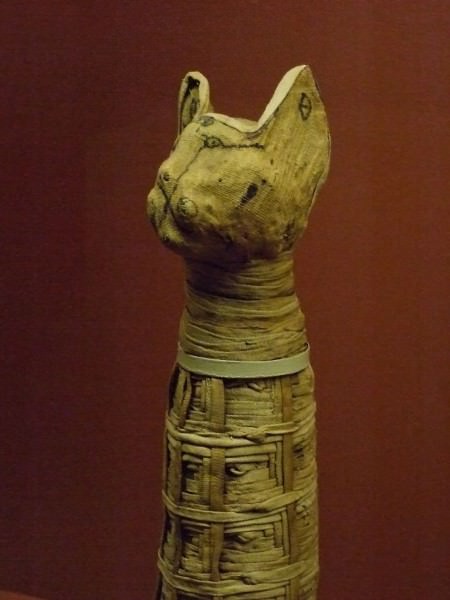
Cat Mummy
The removal of the organs and brain was all about drying out the body. The only organ they left in place, in most eras, was the heart because that was thought to be the seat of the person's identity and character. Blood was drained and organs removed to prevent decay, the body was again washed, and the dressing (linen wrapping) applied.
Although the above processes are the standard observed throughout most of Egypt's history, there were deviations in some eras. Bunson notes:
Each period of ancient Egypt witnessed an alteration in the various organs preserved. The heart, for example, was preserved in some eras, and during the Ramessid dynasties the genitals were surgically removed and placed in a special casket in the shape of the god Osiris. This was performed, perhaps, in commemoration of the god's loss of his own genitals or as a mystical ceremony. Throughout the nation's history, however, the canopic jars were under the protection of the Mesu Heru, the four sons of Horus. These jars and their contents, the organs soaked in resin, were stored near the sarcophagus in special containers. (175)
FUNERAL RITES & BURIAL
Once the organs had been removed and the body washed, the corpse was wrapped in linen - either by the embalmers, if one had chosen the most expensive service (who would also include magical amulets and charms for protection in the wrapping), or by the family - and placed in a sarcophagus or simple coffin. The wrapping was known as the 'linen of yesterday' because, initially, poor people would give their old clothing to the embalmers to wrap the corpse in. This practice eventually led to any linen cloth used in embalming known by the same name.
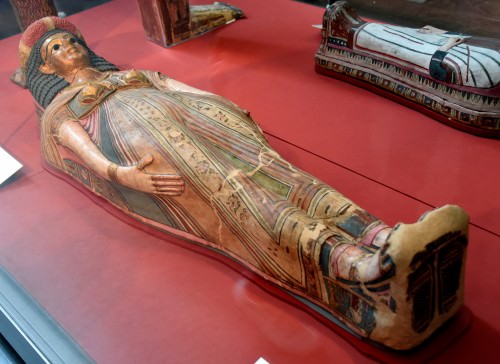
Painted & Gilded Mummy Case of an Unamed Woman
The funeral was a public affair at which, if one could afford them, women were hired as professional mourners. These women were known as the 'Kites of Nephthys' and would encourage people to express their grief through their own cries and lamentation. They would reference the brevity of life and how suddenly death came but also gave assurance of the eternal aspect of the soul and the confidence that the deceased would pass through the trial of the weighing of the heart in the afterlife by Osiris to pass on to paradise in the Field of Reeds.
Grave goods, however rich or modest, would be placed in the tomb or grave. These would include shabti dolls who, in the afterlife, could be woken to life through a spell and assume the dead person's tasks. Since the afterlife was considered an eternal and perfect version of life on earth, it was thought there was work there just as in one's mortal life. The shabti would perform these tasks so the soul could relax and enjoy itself. Shabti dolls are important indicators to modern archaeologists on the wealth and status of the individual buried in a certain tomb; the more shabti dolls, the greater the wealth.

Shabti Box
Besides the shabti, the person would be buried with items thought necessary in the afterlife: combs, jewelry, beer, bread, clothing, one's weapons, a favorite object, even one's pets. All of these would appear to the soul in the afterlife and they would be able to make use of them. Before the tomb was sealed, a ritual was enacted which was considered vital to the continuation of the soul's journey: the Opening of the Mouth Ceremony. In this rite, a priest would invoke Isis and Nephthys (who had brought Osiris back to life) as he touched the mummy with different objects (adzes, chisels, knives) at various spots while anointing the body. In doing so, he restored the use of ears, eyes, mouth, and nose to the deceased.
The son and heir of the departed would often take the priest's role, thus further linking the rite with the story of Horus and his father Osiris. The deceased would now be able to hear, see, and speak and was ready to continue the journey. The mummy would be enclosed in the sarcophagus or coffin, which would be buried in a grave or laid to rest in a tomb along with the grave goods, and the funeral would conclude. The living would then go back to their business, and the dead were then believed to go on to eternal life.
LICENSE
Article based on information obtained from these sources:with permission from the Website Ancient History Encyclopedia
Content is available under License Creative Commons: Attribution-NonCommercial-ShareAlike 3.0 Unported. CC-BY-NC-SA License